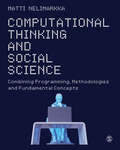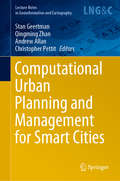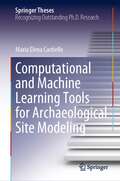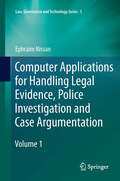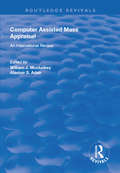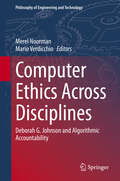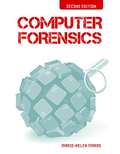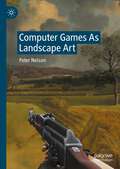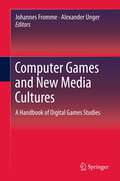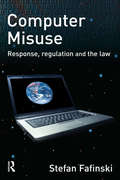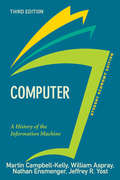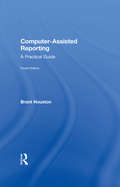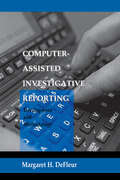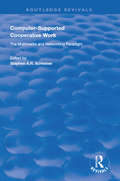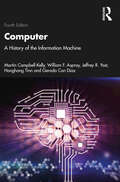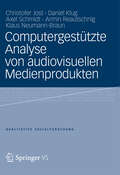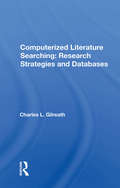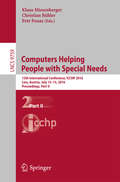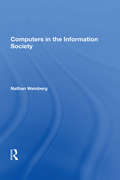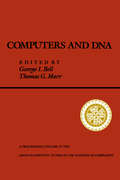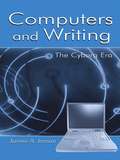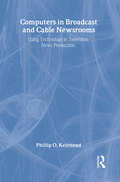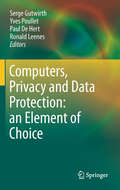- Table View
- List View
Computational Thinking and Social Science: Combining Programming, Methodologies and Fundamental Concepts
by Matti NelimarkkaWhilst providing a fundamental understanding of computational social science, this book delves into the tools and techniques used to build familiarity with programming and gain context into how, why and when they are introduced. The overall focus is on helping you understand and design computational social science research, alongside delving into hands-on coding and technical instruction. Key features include: Further reading Exercises accompanied by sample code Programming examples in Scratch, Python and R Key concepts Chapter summaries With experience in course design and teaching, Matti Nelimarkka has a deep understanding of learning techniques within computational social sciences, with the main aim of blending researching, thinking and designing together to gain a grounded foundation for coding, programming, methodologies and key concepts.
Computational Thinking and Social Science: Combining Programming, Methodologies and Fundamental Concepts
by Matti NelimarkkaWhilst providing a fundamental understanding of computational social science, this book delves into the tools and techniques used to build familiarity with programming and gain context into how, why and when they are introduced. The overall focus is on helping you understand and design computational social science research, alongside delving into hands-on coding and technical instruction. Key features include: Further reading Exercises accompanied by sample code Programming examples in Scratch, Python and R Key concepts Chapter summaries With experience in course design and teaching, Matti Nelimarkka has a deep understanding of learning techniques within computational social sciences, with the main aim of blending researching, thinking and designing together to gain a grounded foundation for coding, programming, methodologies and key concepts.
Computational Urban Planning and Management for Smart Cities (Lecture Notes in Geoinformation and Cartography)
by Stan Geertman Andrew Allan Qingming Zhan Christopher PettitThis book contains a selection of the best articles presented at the CUPUM (Computational Urban Planning and Urban Management) conference, held in the second week of July 2019 at the University of Wuhan, China. The chapters included were selected based on a double-blind review process involving external reviewers.
Computational and Machine Learning Tools for Archaeological Site Modeling (Springer Theses)
by Maria Elena CastielloThis book describes a novel machine-learning based approach to answer some traditional archaeological problems, relating to archaeological site detection and site locational preferences. Institutional data collected from six Swiss regions (Zurich, Aargau, Grisons, Vaud, Geneva and Fribourg) have been analyzed with an original conceptual framework based on the Random Forest algorithm. It is shown how the algorithm can assist in the modelling process in connection with heterogeneous, incomplete archaeological datasets and related cultural heritage information. Moreover, an in-depth review of past and more recent works of quantitative methods for archaeological predictive modelling is provided. The book guides the readers to set up their own protocol for: i) dealing with uncertain data, ii) predicting archaeological site location, iii) establishing environmental features importance, iv) and suggest a model validation procedure. It addresses both academics and professionals in archaeology and cultural heritage management, and offers a source of inspiration for future research directions in the field of digital humanities and computational archaeology.
Computer Applications for Handling Legal Evidence, Police Investigation and Case Argumentation (Law, Governance and Technology Series #5)
by Ephraim NissanThis book provides an overview of computer techniques and tools -- especially from artificial intelligence (AI) -- for handling legal evidence, police intelligence, crime analysis or detection, and forensic testing, with a sustained discussion of methods for the modelling of reasoning and forming an opinion about the evidence, methods for the modelling of argumentation, and computational approaches to dealing with legal, or any, narratives. By the 2000s, the modelling of reasoning on legal evidence has emerged as a significant area within the well-established field of AI & Law. An overview such as this one has never been attempted before. It offers a panoramic view of topics, techniques and tools. It is more than a survey, as topic after topic, the reader can get a closer view of approaches and techniques. One aim is to introduce practitioners of AI to the modelling legal evidence. Another aim is to introduce legal professionals, as well as the more technically oriented among law enforcement professionals, or researchers in police science, to information technology resources from which their own respective field stands to benefit. Computer scientists must not blunder into design choices resulting in tools objectionable for legal professionals, so it is important to be aware of ongoing controversies. A survey is provided of argumentation tools or methods for reasoning about the evidence. Another class of tools considered here is intended to assist in organisational aspects of managing of the evidence. Moreover, tools appropriate for crime detection, intelligence, and investigation include tools based on link analysis and data mining. Concepts and techniques are introduced, along with case studies. So are areas in the forensic sciences. Special chapters are devoted to VIRTOPSY (a procedure for legal medicine) and FLINTS (a tool for the police). This is both an introductory book (possibly a textbook), and a reference for specialists from various quarters.
Computer Assisted Mass Appraisal: An International Review (Routledge Revivals)
by William J. McCluskey Alastair AdairFirst published in 1997, this volume emerged in response to the need for material on the research, development, use and application of mass appraisal techniques for ad valorem property tax systems. The primary paradigms discussed include regression, base home technique, adaptive estimation procedure and artificial neural networks. Intending to address a wide range of property types, the authors explored residential, condominiums, retail, office and industrial property as well as agricultural and forestry land.
Computer Ethics Across Disciplines: Deborah G. Johnson and Algorithmic Accountability (Philosophy of Engineering and Technology #44)
by Merel Noorman Mario VerdicchioThis edited volume brings together philosophers and scholars in disparate fields who have engaged in Professor Deborah G. Johnson’s body of work throughout her long career. It appeals to both students and researchers and introduces Johnson’s thought to a broader audience. This text shows how with due to the resurgence of AI research, her work is more relevant than ever. The volume will help a new generation of scholars benefit from the conceptual insights that Johnson has provided. Her work on algorithmic accountability sets the tone in particular. Chapters illustrate how combining philosophy of technology across disciplines helps clarify the complex intricacies of AI and societies, in particular the topic of accountability. Other themes covered include moral agency and responsibility, transparency, gender and technology as well as ethics education.
Computer Forensics: Cybercriminals, Laws, and Evidence
by Marie-Helen MarasAn Updated Edition of the Definitive Computer Forensics Text. Updated to include the most current events and information on cyberterrorism, the second edition of Computer Forensics: Cybercriminals, Laws, and Evidence continues to balance technicality and legal analysis as it enters into the world of cybercrime by exploring what it is, how it is investigated, and the regulatory laws around the collection and use of electronic evidence. Students are introduced to the technology involved in computer forensic investigations and the technical and legal difficulties involved in searching, extracting, maintaining, and storing electronic evidence, while simultaneously looking at the legal implications of such investigations and the rules of legal procedure relevant to electronic evidence. Significant and current computer forensic developments are examined, as well as the implications for a variety of fields including computer science, security, criminology, law, public policy, and administration.
Computer Games As Landscape Art
by Peter NelsonThis book proposes that computer games are the paradigmatic form of contemporary landscape and offers a synthesis of art history, geography, game studies and play. Like paint on canvas, the game engine is taken as the underlying medium, and using the Valve Source Engine as the primary case study, it analyses landscapes according to the technical, economic and cultural features this medium affords. It presents the single-player first-person shooter (Half-Life 2) as a Promethean safari, examines how the economics of gambling and product placement shaped the eSports landscapes of Counter-Strike and reveals how sandboxes such as Garry’s Mod visualise the radical landscape of Web 2.0. This book explores how our relationship to the environment is changing, how we express this through computer games and how we can move beyond examining artistic influences on games to examining how historical connections flow through games and the history of landscape images.
Computer Games and New Media Cultures: A Handbook of Digital Games Studies
by Alexander Unger Johannes FrommeDigital gaming is today a significant economic phenomenon as well as being an intrinsic part of a convergent media culture in postmodern societies. Its ubiquity, as well as the sheer volume of hours young people spend gaming, should make it ripe for urgent academic enquiry, yet the subject was a research backwater until the turn of the millennium. Even today, as tens of millions of young people spend their waking hours manipulating avatars and gaming characters on computer screens, the subject is still treated with scepticism in some academic circles. This handbook aims to reflect the relevance and value of studying digital games, now the subject of a growing number of studies, surveys, conferences and publications. As an overview of the current state of research into digital gaming, the 42 papers included in this handbook focus on the social and cultural relevance of gaming. In doing so, they provide an alternative perspective to one-dimensional studies of gaming, whose agendas do not include cultural factors. The contributions, which range from theoretical approaches to empirical studies, cover various topics including analyses of games themselves, the player-game interaction, and the social context of gaming. In addition, the educational aspects of games and gaming are treated in a discrete section. With material on non-commercial gaming trends such as 'modding', and a multinational group of authors from eleven nations, the handbook is a vital publication demonstrating that new media cultures are far more complex and diverse than commonly assumed in a debate dominated by concerns over violent content.
Computer Misuse: Response, Regulation and the Law
by Stefan FafinskiThis book is concerned with the nature of computer misuse and the legal and extra-legal responses to it. It explores what is meant by the term 'computer misuse' and charts its emergence as a problem as well as its expansion in parallel with the continued progression in computing power, networking, reach and accessibility. In doing so, it surveys the attempts of the domestic criminal law to deal with some early manifestations of computer misuse and the consequent legislative passage of the Computer Misuse Act 1990. This book will be of interest to students of IT law as well as to sociologists and criminologists, and those who have a professional concern with preventing computer misuse and fraud.
Computer, Student Economy Edition: A History of the Information Machine (The Sloan Technology Series)
by Martin Campbell-KellyAn exploration of the computer, tracing not only the development of the machine itself, but also chronicling the effects of manufacturing and sales innovations by companies that made the boom possible.
Computer-Assisted Reporting: A Practical Guide (4th Edition)
by Brant HoustonThis straightforward and effective how-to guide provides the basics for any journalist or student beginning to use data for news stories. It has step-by-step instructions on how to do basic data analysis in journalism while addressing why these digital tools should be an integral part of reporting in the 21st century. The book pays particular attention to the need for accuracy in computer-assisted reporting and to both the potential and pitfalls in utilizing large datasets in journalism. An ideal core text for courses on data-driven journalism or computer-assisted reporting, Houston pushes back on current trends by helping current and future journalists become more accountable for the accuracy and relevance of the data they acquire and share. Online instructor's materials are available to adopting professors, and additional exercises are available free online to students at the below address: http://ire.org/carbook/username: carbookpassword: carbook4
Computer-assisted Investigative Reporting: Development and Methodology (Routledge Communication Series)
by Margaret H. DeFleurConducting computer analyses for the purposes of revealing information of significance to the press represents an extension of one of the most important forms of American journalism into the contemporary era of new technologies. Investigative reporting had its start with the establishment of the metropolitan newspaper during the early decades of the 1900s. At the time, it was a continuation of the evolving tradition of freedom of the press that had characterized American political life since colonial times. As it developed, investigative reporting stressed facts rather than the opinions of the editor or reporter. In turn, that tradition had its own intellectual roots. Today, computer-assisted investigative reporting (CAIR) extends that "marketplace of ideas" into systematic examinations of the electronic records of government. In addition, computer analyses of other kinds of information systematically gathered by journalists can provide the press with insights into trends and patterns unlikely to be revealed by other means. This unique volume addresses procedures and issues in investigative journalism that have not been explained in other publications. It sets forth -- for the first time -- a detailed and specific methodology for conducting computer-assisted investigative analyses of both large and small scale electronic records of government and other agencies. That methodology consists of the logic of inquiry, strategies for reaching valid conclusions, and rules for reporting what has been revealed by the analyses to the public in clear ways. Such systematic methodologies are essential in social and other sciences and the development of a counterpart for investigative journalism has been badly needed. That systematic methodology is developed within a context that explains the origin and major characteristics of those elements that have come together in American society to make computer-assisted investigative reporting both possible and increasingly a part of standard newsroom practices. These include the development of traditional investigative journalism, the evolution of computer technology, the use of computers by government to keep records, the legal evolution of freedom of information laws, the rapid adoption of computers in newsrooms, the increasing importance of precision journalism, and the sharp increase in recent times of computer-assisted investigative reporting by American newspapers both large and small. The issues addressed in this book are discussed in a very readable context with an abundance of examples and illustrations drawn from the real world of journalism as it is practiced daily in newsrooms around the country. Explanations of concepts, principles, and procedures are set forth in layperson's terms that require very little in the way of knowledge of computers or statistical methods.
Computer-supported Cooperative Work (Routledge Revivals)
by Stephen A.R. ScrivenerPublished in 1994, this work supplies an up-to-date view of Computer-Supported Cooperative Work (CSCW) and its role in empowering groups to achieve better solutions faster. The enabling technology and group organizational and behavioural aspects of CSCW should be of interest to a wide audience.
Computer: A History of the Information Machine
by Martin Campbell-Kelly Jeffrey R. Yost William F. Aspray Honghong Tinn Gerardo Con DíazComputer: A History of the Information Machine traces the history of the computer and its unlimited, information-processing potential. Comprehensive and accessibly written, this fully updated fourth edition adds new chapters on the globalization of information technology, the rise of social media, fake news, and the gig economy, and the regulatory frameworks being put in place to tame the ubiquitous computer. Computer is an insightful look at the pace of technological advancement and the seamless way computers are integrated into the modern world. The authors examine the history of the computer, including the first steps taken by Charles Babbage in the nineteenth century, and how wartime needs and the development of electronics led to the giant ENIAC, the first electronic computer. For a generation IBM dominated the computer industry. In the 1980s, the desktop PC liberated people from room-sized mainframe computers. Next, laptops and smartphones made computers available to half of the world’s population, leading to the rise of Google and Facebook, and powerful apps that changed the way we work, consume, learn, and socialize. The volume is an essential resource for scholars and those studying computer history, technology history, and information and society, as well as a range of courses in the fields of computer science, communications, sociology, and management.
Computer: A History of the Information Machine
by Martin Campbell-Kelly Jeffrey R. Yost William F. Aspray Honghong Tinn Gerardo Con DíazComputer: A History of the Information Machine traces the history of the computer and its unlimited, information-processing potential.Comprehensive and accessibly written, this fully updated fourth edition adds new chapters on the globalization of information technology, the rise of social media, fake news, and the gig economy, and the regulatory frameworks being put in place to tame the ubiquitous computer. Computer is an insightful look at the pace of technological advancement and the seamless way computers are integrated into the modern world. The authors examine the history of the computer, including the first steps taken by Charles Babbage in the nineteenth century, and how wartime needs and the development of electronics led to the giant ENIAC, the first electronic computer. For a generation IBM dominated the computer industry. In the 1980s, the desktop PC liberated people from room-sized mainframe computers. Next, laptops and smartphones made computers available to half of the world’s population, leading to the rise of Google and Facebook, and powerful apps that changed the way we work, consume, learn, and socialize.The volume is an essential resource for scholars and those studying computer history, technology history, and information and society, as well as a range of courses in the fields of computer science, communications, sociology, and management.
Computergestützte Analyse von audiovisuellen Medienprodukten (Qualitative Sozialforschung #22)
by Klaus Neumann-Braun Armin Reautschnig Christofer Jost Axel Schmidt Daniel KlugAusgehend vom Musikvideo als Paradigma audiovisueller Kompositionalität, widmet sich der Band grundsätzlich relevanten Dimensionen der Transkription von Videodaten sowie insbesondere der Spezifik von Medienproduktanalysen. Im Fokus steht das neuentwickelte Analyseinstrument "trAVis". Hierbei handelt es sich um ein musikzentriertes Transkriptionsprogramm für audiovisuelle Medienprodukte, das als frei zugängliche Web-Applikation konzipiert ist. Anhand einer umfassenden Fallanalyse wird aufgezeigt, dass "trAVis" eine gegenstandsangemessene Analyse musikbasierter Audiovisionsformate ermöglicht. Forschungsstrategisch betrachtet, ist das Programm darauf angelegt, bildbezogene und texthermeneutische Ansätze mit musikwissenschaftlichen Zugängen zu verbinden.
Computerized Literature Searching: Research Strategies And Databases
by Charles L. GilreathThe computer terminal is well on its way to being as commonplace as the telephone, and its usefulness to the scholar and scientist is so great that already computer screens and disks are seen frequently in academic offices. The value of computers in research is well established, with vast amounts of data being processed daily by all sizes of computers. Computers also have had dramatic effects on the researcher's literature-searching options: Scientists and scholars can now query enormous databases containing tens of millions of citations to published literature and can extract bibliographies tailored to their specific questions. The power and flexibility afforded the user of information by these literature-searching systems ease the burden of library work, but in order to use the systems effectively, it is necessary to understand both their capabilities and their limitations. Mr. Gilreath describes the principles underlying online bibliographic systems, the databases available, and the factors a researcher must consider in using them. He explores in some depth the relationship of the structure and terminology of publications in various fields to the literature-searching process and provides detailed guidelines for research in the life, health, agricultural, and social sciences, chemistry, physics, mathematics, geology, meteorology, engineering, education, psychology, business, law, current affairs, and the humanities. A glossary of literature-searching terms is included.
Computers Helping People with Special Needs: 15th International Conference, ICCHP 2016, Linz, Austria, July 13-15, 2016, Proceedings, Part II (Lecture Notes in Computer Science #9759)
by Klaus Miesenberger Christian Bühler Petr PenazThe introduction to the 1st International Conference on Computers for Han- cappedPersons(Vienna,1989)byAMinTjoa(UniversityofVienna)andRoland Wagner(UniversityofLinz)?nishedwiththefollowingmissionstatementonthe "Future Direction on Computers for Handicapped Persons": "The di'erent themes show that a lot of problems are solved by the usage of computer technology for helping handicapped persons, for instance for the blind and visually handicapped. A consequence of the discussed themes there are two directions which should be done in the next years. One direction is obvious. The tools must be improved and research and development work should be extended to all groups of handicapped (even if they are numerically not so large as for instancetheblindorvisuallyhandicappedpersons). Ontheothersideinthearea of social implications there is an increasing demand on social science studies on overall computer use among disabled persons. Because sources are in principle missing today about disabled persons work tasks, research in this ?eld must begin by trying to survey this aspect. Particular attention should be paid to the extent and character of computer use among the handicapped in work life. There are a lot of questions, which should be answered during the next years for reaching the aim of rehabilitation. " Fifteen years later the 9th International Conference on Computers Helping People with Special Needs (Paris, 2004) o'ered a comprehensive and deepened view on general awareness,special research and individual applications conce- ing disabled people and their participation in our society.
Computers In The Information Society
by Nathan WeinbergThis book examines the unfolding cultural and organizational impact of computers on human society. Through this analysis, it discusses the role of information technology in people's lives, interdependence between the society and its computer creations, and expectations in the information society.
Computers and DNA: The Proceedings Of The Interface Between Computation Science And Nucleic Acid Sequencing Workshop, Held December 12 To 16, 1988 In Santa Fe, New Mexico (Santa Fe Institute Ser.)
by Thomas MarrThe fields of molecular biology and genetics are faced with an enormous accumulation of information: DNA sequencing, associated sequences of amino acids in proteins, genetics, macromolecular structures and other sets have created a quantitative backlog of data which needs to be organized and analyzed. Moreover, the rate of data acquisitions is accelerating as improved technologies are used and as organized programs such as the Human Genome Initiative are established. Because of this data's importance, molecular biologists have turned to computational scientists for help in processing this mass of information.The Santa Fe Institute organized a workshop on "The Interface Between Computational Science and DNA Sequencing" in 1998 to address this information crisis. Approximately one hundred molecular biologists, computer scientists, mathematicians, and other scientists in diverse fields met to discuss how computational science can best keep pace with molecular biology. The papers presented at that meeting and included in this volume serve as a comprehensive introduction to the field and as a discussion of research on some of the current problems.
Computers and Writing: The Cyborg Era
by James A. InmanIn this book, James A. Inman explores the landscape of the contemporary computers and writing community. Its six chapters engage critical issues, including redefining the community's generally accepted history, connecting its contemporary innovators with its long-standing spirit of innovation, advocating for increased access and diversity, and more. Between chapters, readers will find "Community Voices" sections, which provide a snapshot of the contemporary computers and writing community and introduce, in a non-hierarchical form, more than 100 of its members from around the world, in their own voices. Computers and Writing: The Cyborg Era features a simultaneous emphasis on individuals, communities, and contexts they share; a creative rethinking of the character and values of the computers and writing community; a holistic exploration of meaning-making; and an activist approach to pedagogy. It is a must-read book for anyone interested in rhetoric, technology, and pedagogy, including faculty, graduate students, and colleagues in professions outside the academy.
Computers in Broadcast and Cable Newsrooms: Using Technology in Television News Production (Routledge Communication Series)
by Phillip O. KeirsteadComputers in Broadcast and Cable Newsrooms: Using Technology in Television News Production takes readers through the use of computers and software in the broadcast/cable newsroom environment. Author Phillip O. Keirstead began writing about television news technology decades ago in an effort to help television news managers cope with technological change. In this text, he demonstrates the myriad ways in which today's journalism is tied to technology, and he shows how television news journalists rely on varied and complex technologies to produce timely, interesting, and informative broadcasts. Using a hands-on, practical approach to cover the role computers play in various parts of the newsroom, the volume will be of great practical value to undergraduate and graduate students in advanced broadcast/news television courses.
Computers, Privacy and Data Protection: An Element Of Choice
by Paul De Hert Yves Poullet Serge Gutwirth Ronald LeenesThis timely interdisciplinary work on current developments in ICT and privacy/data protection, coincides as it does with the rethinking of the Data Protection Directive, the contentious debates on data sharing with the USA (SWIFT, PNR) and the judicial and political resistance against data retention. The authors of the contributions focus on particular and pertinent issues from the perspective of their different disciplines which range from the legal through sociology, surveillance studies and technology assessment, to computer sciences. Such issues include cutting-edge developments in the field of cloud computing, ambient intelligence and PETs; data retention, PNR-agreements, property in personal data and the right to personal identity; electronic road tolling, HIV-related information, criminal records and teenager's online conduct, to name but a few.
